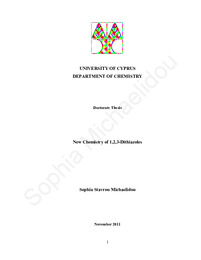New chemistry of 1,2,3-dithiazoles
Date
2012-01Author
Michaelidou, Sofia StavrouPublisher
Πανεπιστήμιο Κύπρου, Σχολή Θετικών και Εφαρμοσμένων Επιστημών / University of Cyprus, Faculty of Pure and Applied SciencesPlace of publication
ΚύπροςCyprus
Google Scholar check
Keyword(s):
Metadata
Show full item recordAbstract
Το ενδιαφέρον μας στη χημεία των 1,2,3-διθειαζολών προκύπτει από το γεγονός ότι τα διθειαζολικά συστήματα μπορούν να χρησιμοποιηθούν στην προετοιμασία νέων ετεροκυκλικών συστημάτων με σημαντικές βιολογικές ιδιότητες. Ένας από τους στόχους της ερευνητικής αυτής εργασίας ήταν η σύνθεση και μελέτη των αντιδράσεων των Ν-πύριδο-αρωματικών διθειαζολιμινών. Το επόμενο βήμα ήταν η μελέτη αντιδράσεων κυκλοποίησης των μορίων αυτών είτε μέσω αντιδράσεων θερμόλυσης είτε με τη χρήση θειοφιλικών αντιδραστηρίων. Τα επιθυμητά προιόντα κυκλοποίησης λήφθηκαν σε ψηλές αποδόσεις. Πραγματοποιήθηκαν και μελέτες πυρηνόφιλης προσβολής διαφόρων αμινών σε ό-κυάνο υποκατεστημένες διθειαζολιμίνες, οι οποίες έδωσαν πρόσβαση σε πυριδοπυριμιδίνες και πύριδογουανιδίνες. Στην περίπτωση της διαιθυλαμίνης απομονώθηκε και μια 2,2’-κινοειδής διθειαζόλη. Επιπλέον, η διθειαζολιμίνη αυτή αφέθηκε να αντιδράσει με αμμωνία, NaN3 και τριφαίνυλοφωσφίνη. Η τελευταία οδήγησε στο μη-αναμενόμενο σχηματισμό ενός 3-αμινο-ινδολο-2-καρβονιτρίλιου κάτι το οποίο μελετήθηκε περαιτέρω. Oκτώ νέες 2-κυανο υποκατεστημένες διθειαζολιμίνες συντέθηκαν οι οποίες αφέθηκαν να αντιδράσουν με τριφαίνυλοφωσφίνη δίνοντας 7 νέες ινδόλες με μόνη εξαίρεση την περίπτωση της 4,5-διμεθοξυ-διθειαζολιμίνης, η οποία οδήγησε στο σχηματισμό μιας βενζοπυριμιδίνης. Περαιτέρω μελέτη του μηχανισμού σχηματισμού των ινδολών οδήγησε στην ανεξάρτητη σύνθεση του αμινοθειοφορμαμιδίου, το οποίο αποτελεί το σημαντικότερο ενδιάμεσο μόριο. Αντίδραση των 8 νέων αμινοθειοφορμαμιδίων με τριφαίνυλοφωσφίνη οδήγησε στο σχηματισμό των αναμενόμενων ινδολών σε ψηλές αποδόσεις, με μόνη εξαίρεση και πάλι το 4,5-διμεθόξυ παράγωγο. Για το λόγο αυτό αναπτύχθηκαν δύο ανεξάρτητες συνθετικές πορείες προς το σχηματισμό των ινδολών. Η πρώτη συνθετική πορεία είναι βελτίωση της βιβλιογραφίας και αποτελείται από 4 στάδια (προστασία με TsCl, αλκυλίωση, κυκλοποίηση και αποπρωστασία). Η δεύτερη συνθετική πορείς αποτελείται από δύο στάδια (αλκυλίωση και κυκλοποίηση σε συνθήκες MW). Our interest focuses on the chemistry of 1,2,3-dithiazoles because of their unusual physical properties, biological activity and synthetic utility since the constructed dithiazoles can be converted into new heterocyclic systems via ring transformation. However, only few examples of (4-chloro-5H-1,2,3-dithiazolylideneamino)azines exist in the literature. For this reason a range of (4-chloro-5H-1,2,3-dithiazolylideneamino)azines was synthesized and the reaction conditions were optimized. Fourteen heteroazinyl were successfully synthesized. Cyclization reactions of the dithiazolylidenes using thermolysis conditions or in the presence of a thiophilic reagent gave the corresponding thiazolopyridine-2-carbonitriles in moderate to high yields. Cyclization reactions of the hydroxyl substituted dithiazolylidenes using thermolysis conditions or in the presence of base, gave the corresponding oxazoles and oxazines in moderate to high yields. The oxazines could also be rearranged to the corresponding oxazoles. The behavior of 2-(4-chloro-5H-1,2,3-dithiazol-5-ylideneamino)-6-ethoxy-4-phenylpyridine-3,5-dicarbonitrile in the presence of several amines and Ph3P was also investigated. This chemistry gave access to a wide range of heterocyclic compounds. The most important result was in the case of Ph3P which gave as products the fully substituted 3-aminoindole-2-carbonitrile, (2-cyanoindol-3-yl)iminotriphenylphosphorane and 6-cyano-5-oxo-7-phenyl-2,5-bis(tri-phenyl-phosphino)imidazo[1,2-a]pyridin-4-ium-1-ide. In order to further investigate this chemistry, a range of 3-aminoindole-2-carbonitriles were synthesized. An important intermediate for the dithiazolylidene to indole transformation is the 2-cyano cyanothioformanilide. Seven 2-cyano cyanothioformanilides were synthesized in high yields. Furthermore, two synthetic routes toward the formation of 3-aminoindole-2-carbonitriles were also developed. The first one improved on a literature procedure involving 4 synthetic steps (protection using TsCl, alkylation, cyclization and deprotection) and the second synthetic route involved only two synthetic steps (cyanomethylation and cyclization).

